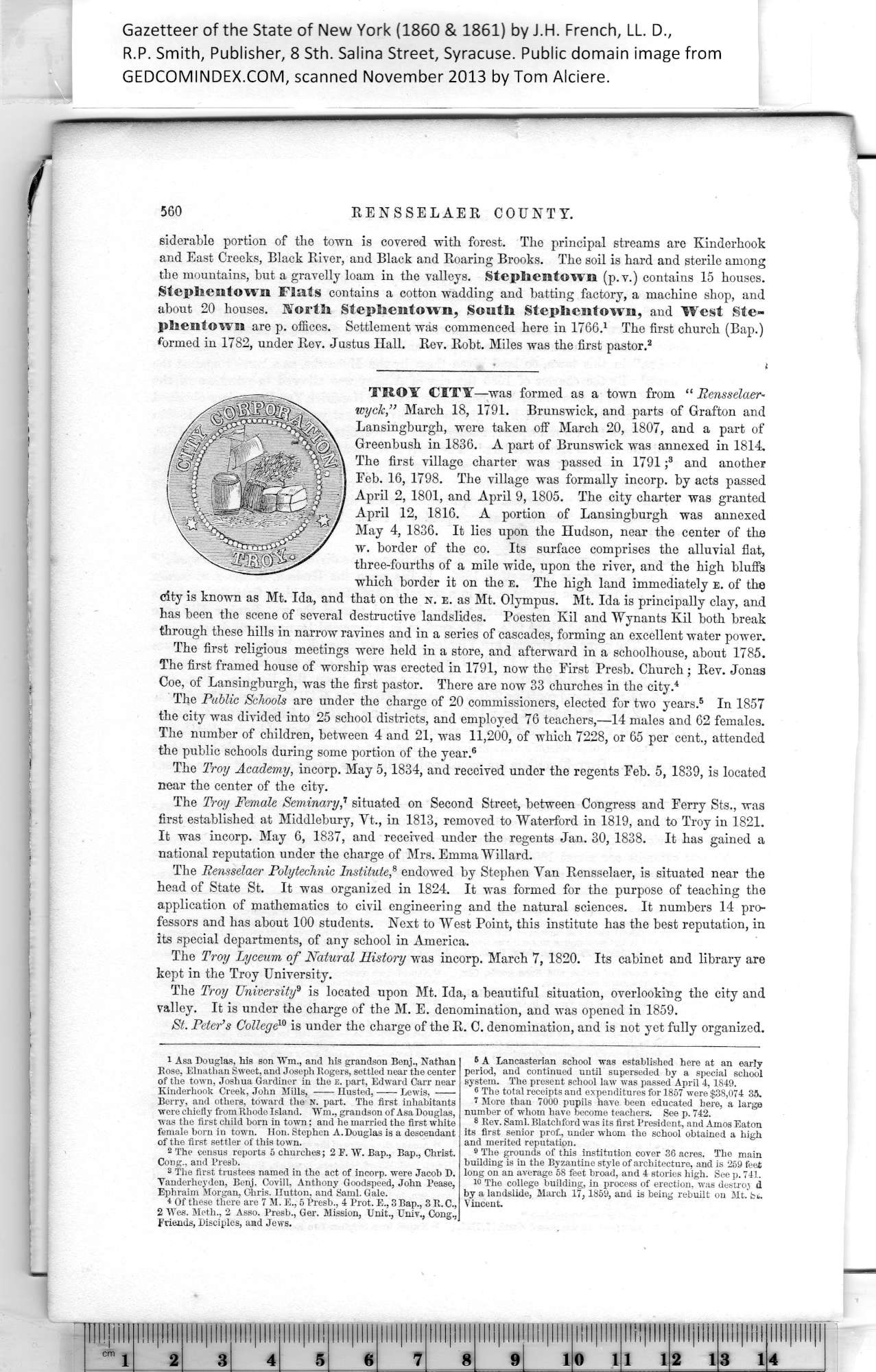|
560 RENSSELAER COUNTY.
eiderable portion of the town is covered with forest. The principal streams are Kinderhook
and East Creeks, Black River, and Black and Roaring Brooks. The soil is hard and sterile among
the mountains, but a gravelly loam in the valleys. Steplieiitowii (p.v.) contains 15 houses.
Stepltentowm Flats contains a cotton wadding and batting factory, a machine shop, and
about 20 houses. North Stephentown, South Stephentown, and West Ste¬
phentown are p. offices. Settlement was commenced here in 1766.1 The first church (Bap.)
formed in 1782, under Rev. Justus Hall. Rev. Robt. Miles was the first pastor.2
TROY CITY—was formed as a town from “ Bensselaer¬
wyck,” March 18, 1791. Brunswick, and parts of Grafton and
Lansingburgh, were taken off March 20, 1807, and a part of
Greenbush in 1836. A part of Brunswick was annexed in 1814
The first village charter was passed in 1791 ;3 and another
Feb. 16, 1798. The village was formally incorp. by acts passed
April 2, 1801, and April 9, 1805. The city charter was granted
April 12, 1816. A portion of Lansingburgh was annexed
May 4, 1836. It lies upon the Hudson, near the center of the
w. border of the co. Its surface comprises the alluvial fiat,
three-fourths of a mile wide, upon the river, and the high bluffs
which border it on the e. The high land immediately e. of the
city is known as Mt. Ida, and that on the sr. e. as Mt. Olympus. Mt. Ida is principally clay, and
has been the scene of several destructive landslides. Poesten Kil and Wynants Kil both break
through these hills in narrow ravines and in a series of cascades, forming an excellent water power.
The first religious meetings were held in a store, and afterward in a schoolhouse, about 1785.
The first framed house of worship was erected in 1791, now the First Presb. Church; Rev. Jonas
Coe, of Lansingburgh, was the first pastor. There are now 33 churches in the city.4
The Public Schools are under the charge of 20 commissioners, elected for two years.5 In 1857
the city was divided into 25 school districts, and employed 76 teachers,—14 males and 62 females.
The number of children, between 4 and 21, was 11,200, of which 7228, or 65 per cent., attended
the public schools during some portion of the year.6
The Troy Academy, incorp. May 5,1834, and received under the regents Feb. 5, 1839, is located
near the center of the city.
The Troy Female Seminary,’' situated on Second Street, between Congress and Ferry Sts., was
first established at Middlebury, Yt., in 1813, removed to Waterford in 1819, and to Troy in 1821.
It was incorp. May 6, 1837, and received under the regents Jan. 30, 1838. It has gained a
national reputation under the charge of Mrs. Emma Willard.
The Bensselaer Polytechnic Institute,8 endowed by Stephen Van Rensselaer, is situated near the
head of State St. It was organized in 1824. It was formed for the purpose of teaching the
application of mathematics to civil engineering and the natural sciences. It numbers 14 pro¬
fessors and has about 100 students. Next to West Point, this institute has the best reputation, in
its special departments, of any school in America.
The Troy Lyceum of Natural History was incorp. March 7, 1820. Its cabinet and library are
kept in the Troy University.
The Troy University9 is located upon Mt. Ida, a beautiful situation, overlooking the city and
valley. It is under the charge of the M. E. denomination, and was opened in 1859.
St. Peter’s College10 is under the charge of the R. C. denomination, and is not yet fully organized.
|
6 A Lancasterian school was established here at an early
period, and continued until superseded by a special school
system. The present school law was passed April 4, 1849.
6 The total receipts and expenditures for 1857 were $38,074 35.
1 More than 7000 pupils have been educated here, a large
number of whom have become teachers. See p. 742.
8 Rev. Sami. Blatchford was its first President, and Amos Eaton
its first senior prof., under whom the school obtained a high
and merited reputation.
9 The grounds of this institution cover 36 acres. The main
building is in the Byzantine style of architecture, and is 259 feet
long on an average 58 feet broad, and 4 stories high. See p. 741.
10 The college building, in process of erection, was destroy d
by a landslide, March 17, 1859, and is being rebuilt on Mtfcu
Vincent. |
1
Asa Douglas, his son Wm., and his grandson Benj., Nathan
Bose, Elnathan Sweet, and Joseph Rogers, settled near the center
of the town, Joshua Gardiner in the e. part, Edward Carr near
Kinderhook Creek, John Mills, Husted, Lewis, -
Berry, and others, toward the n. part. The first inhabitants
were chiefly from Rhode Island. Wm., grandson of Asa Douglas,
was the first child born in town; and he married the first white
female born in town. Hon. Stephen A. Douglas is a descendant
of the first settler of this town.
2
The census reports 5 churches; 2 E. W. Bap., Bap., Christ.
Cong., and Presb.
|
